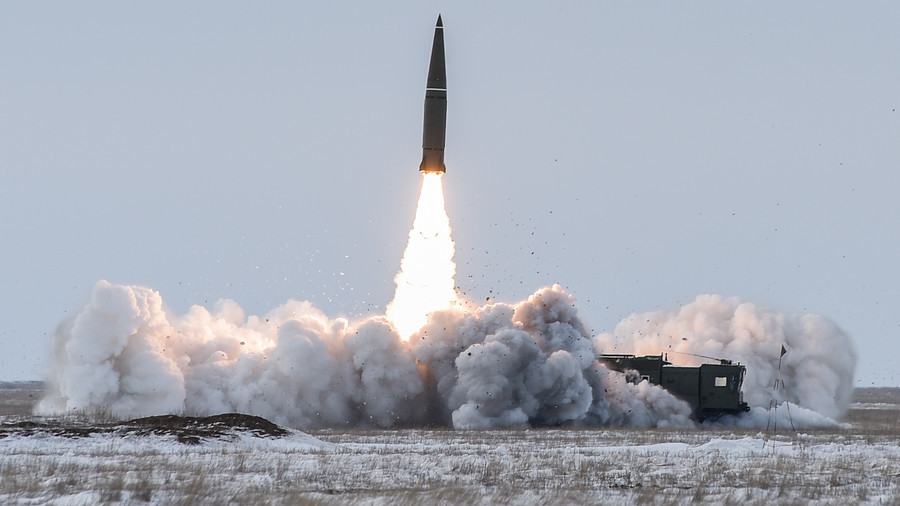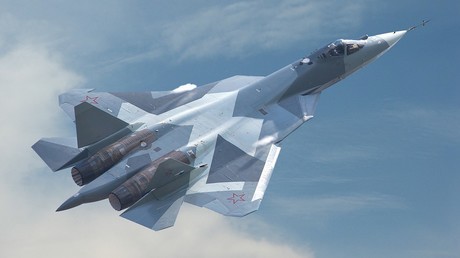US' ultimate goal is to strip Russia of its nukes

The US' single strategic objective, in terms of Russian nuclear triad, is to strip it of its arsenal. This is what shapes all of the White House's foreign policy while any talk about nuclear arms reduction is just cover for that.
Last week, US President Donald Trump announced plans to pull out of the Intermediate-Range Nuclear Forces (INF) Treaty. Since signing the document in 1987, the USSR/Russia had to get rid of several highly promising pieces of military hardware, such as intermediate-range two-stage solid-fuel ballistic missile, known as Pioner, with the associated mobile launchers and the Oka mobile theatre ballistic missile system. It's worth noting that these systems had outstanding operational capabilities, and their combat potential was a great concern to the US.
Under Boris Yeltsin, Russia almost lost its strategic air force and heavy multiple-warhead ballistic missiles. In comparison, what the US had to give up looks like a bare minimum.
So, let's not be under any illusion that negotiations with the US on limiting or reducing any types of nuclear weapons could actually lead to strengthening global peace and security or building mutual trust. Their one and only goal is to disarm Russia completely and finish it off.
Looming US withdrawal from the INF Treaty could theoretically lead to the US deploying its intermediate-range missiles in the Baltic states and Ukraine.
Up until 1987, US ground-launched cruise missiles BGM-109G Gryphon were based at Greenham Common and Molesworth (Britain), Wueschheim (Germany), Comiso (Italy) and Florennes (Belgium) – a total of 309 missiles across Europe. About 100 intermediate-range Pershing II ballistic missiles were placed near Schwäbisch Gmünd, Neu-Ulm, and Neckarsulm in West Germany.
Up until 1987, US ground-launched cruise missiles BGM-109G Gryphon were based at Greenham Common and Molesworth (Britain), Wueschheim (Germany), Comiso (Italy) and Florennes (Belgium) – a total of 309 missiles across Europe. About 100 intermediate-range Pershing II ballistic missiles were placed near Schwäbisch Gmünd, Neu-Ulm, and Neckarsulm in West Germany.
And now similar weapons could be deployed several hundred kilometers to the east, almost at the current western border of Russia.
Today, the deployment of US intermediate-range ballistic missiles and ground-based cruise missiles, for instance, around Kharkov, Chernigov or Mariupol in Ukraine, sounds like a nightmare.
Unfortunately, we have good reason to believe that the current Ukrainian regime won't put any political obstacles in the way of this. Moreover, Kiev would undoubtedly respond to Washington's plans to deploy missiles on Ukraine's eastern borders with genuine enthusiasm. Similar levels of excitement could be expected from Lithuania, Latvia and Estonia, should the US decide to deploy missiles on their respective territories.
Should this happen, the flight time of an intermediate-range ballistic missile to Russian Armed Forces' crucially important facilities in the European part of the country would be tens of seconds. Russia's top administration would have virtually no time to even consider a retaliatory strike. In addition, the process will render the entire early-warning system based on the Voronezh radar installations ineffective.
Neither would the situation be improved in any substantial way through the use of satellites launched as part of the Unified Space System (EKS) of the Russian Armed Forces.
The purpose of the satellites is to detect ballistic missiles launched by a potential enemy, then calculate their trajectories and determine the impact point of each warhead. There will be practically no time left to perform all these operations and inform the military and political leadership.
In addition, the deployment of military units, equipped with intermediate-range missiles, near the western borders of Russia significantly raises the probability of a disarming strike with the use of conventional weapons, which fits very well with the so-called Prompt Global Strike initiative developed by the US.
In other words, should the US leave the INF Treaty, the resulting situation would be much worse – in terms of potential military and political consequences – compared to the one the Soviet Union faced in the mid-1980s.
Among other things, it is believed that the collapse of the INF Treaty will undermine any further discussions on the topic of strategic offensive arms, making it unlikely that the New START treaty would be extended beyond 2021, when it expires.
However, there are varying opinions with regard to that possibility. Notably, the Kremlin spokesman Dmitry Peskov said it was too early to say whether the statements by President Trump about the US withdrawal from the INF Treaty would affect the future of the New START Treaty.
Finally, a significant part of both Russian and US expert communities believe that America's withdrawal from the INF Treaty would signal the start of an uncontrolled and completely unrestricted nuclear arms race.
On the surface, it may look like that is the case – however, some of the issues can be approached from a slightly different angle. There has been a great deal of exaggeration when it comes to the significance of the agreements signed by Russia and the US in the area of strategic arms reduction and control in the past.
At one time, for example, it was believed that the 1972 ABM Treaty was the cornerstone of global strategic stability, and the US' withdrawal from it would lead to disastrous consequences. It has been over 16 years since they did withdraw from it, back in June 2002. Still no sign of Armageddon.
Likewise, there is absolutely no reason to believe that the termination of the INF Treaty would somehow bring about the end of the world. Besides, even if intermediate-range ballistic missiles and ground-launched cruise missiles are deployed along Russia's western border, in case of a nuclear conflict Moscow would still be able to launch a retaliatory attack, which would happen even if the government and the military are completely crippled and paralyzed.
This will be done by the modern iteration of the Perimeter system (also known as the Dead Hand). In any case, the US and its European allies would suffer a guaranteed level of unacceptable damage, should they attack first. Thus, this whole debate over catastrophic consequences for Russia that may follow the deployment of intermediate-range missiles on its borders if a nuclear war erupts boils down to two key things.
But first, it is necessary to keep in mind that nuclear missile exchange would inevitably lead to the nuclear winter, meaning a true armageddon for humanity. For instance, even a nuclear conflict without intermediate-range missiles would send the global temperature level to -40 °C, while adding the intermediate-range missiles factor would mean even a more drastic cooldown reaching as low as -41°C. That is, there is no big difference whether such missiles would be used or not during a potential nuclear war – either way it would mean a catastrophe of a truly global scale.
Recent statements delivered by Donald Trump has given rise to a wave of speculation regarding Russia's possible response. To begin with, it is clear that Moscow will not be plunging into another nuclear race as it was in the 1950s or 1960s. First, Russia doesn't have enough resources. Second, there is simply no need for it – and that is the real reason. Russia is not going to build up its missile arsenals.
However, if the US indeed leaves the INF, Moscow's hands will be untied and it could revamp its 9К720 Iskander-M missile complex to use long-range cruise missiles. Also, we cannot rule out that Russia would decide to go back to designing a new light ballistic missile such as Kurier or improving combat capabilities of the RS-26 Rubezh. In addition, the 1987 Treaty strictly limits any R&D on target missiles used to test future anti-missile systems, making any work on such missiles almost impossible.
As for Donald Trump's expectations to see China joining the negotiations on a new treaty, it seems that no-one has told him that India, Pakistan and Iran also possess such missiles. And it is highly likely that China will not be interested in talking about any kind of INF Treaty. First, intermediate-range missiles are at the core of Beijing's nuclear capabilities. Second, China will never let go of its DF-21D anti-ship ballistic missiles with the operational range of 1450km (900 miles).
In case of a conflict between China and the US, these very DF-21Ds would not let US carrier battle groups come closer than 1400-1500 km without the risk of being hit. It would neutralize the threat of US jets carrying successful strikes against coastal infrastructure and targets located further ashore. Currently, China is working on further improvements to combat capabilities of the DF-21. Its operational range is expected to reach between 3,000 to 5,000km (1864 to 3107 miles). That said, China will not be giving up on its crucial future weapon so easily.
As for a new treaty, it should be negotiated between all countries who now possess (and can possibly possess) such missiles – the US, Russia, Iran, Pakistan, India, and China. However, it is quite likely that won't happen in any immediate future because of the many conflicting political interests of the countries. At the very best, it seems to be possible to launch consultations and outline the positions of countries that now have intermediate- and shorter-range missiles.
By Mikhail Khodarenok, military commentator for Gazeta.ru
Bio:
Mikhail Khodarenok is a retired colonel. He graduated from the Minsk Higher Engineering School of Anti-Aircraft Missile Defense (1976) and the Command Academy of the Air Defense Forces (1986).
Commanding officer of the S-75 AA missile battalion (1980-1983).
Deputy commanding officer of a SAM regiment (1986-1988).
Senior officer at the High Command of the Air Defense Forces (1988–1992).
Officer at the main operational directorate of the General Staff of the Armed Forces(1992–2000).
Graduated from the Military Academy of the General Staff of the Armed Forces of the Russian Federation (1998).
Worked as an analyst at Nezavisimaya Gazeta (2000-2003) and editor-in-chief of Voyenno-Promyshlennyi Kuriyer (2010-2015).
Commanding officer of the S-75 AA missile battalion (1980-1983).
Deputy commanding officer of a SAM regiment (1986-1988).
Senior officer at the High Command of the Air Defense Forces (1988–1992).
Officer at the main operational directorate of the General Staff of the Armed Forces(1992–2000).
Graduated from the Military Academy of the General Staff of the Armed Forces of the Russian Federation (1998).
Worked as an analyst at Nezavisimaya Gazeta (2000-2003) and editor-in-chief of Voyenno-Promyshlennyi Kuriyer (2010-2015).
Think your friends would be interested? Share this story!
The statements, views and opinions expressed in this column are solely those of the author and do not necessarily represent those of RT.




0 Comments:
Post a Comment
Subscribe to Post Comments [Atom]
<< Home